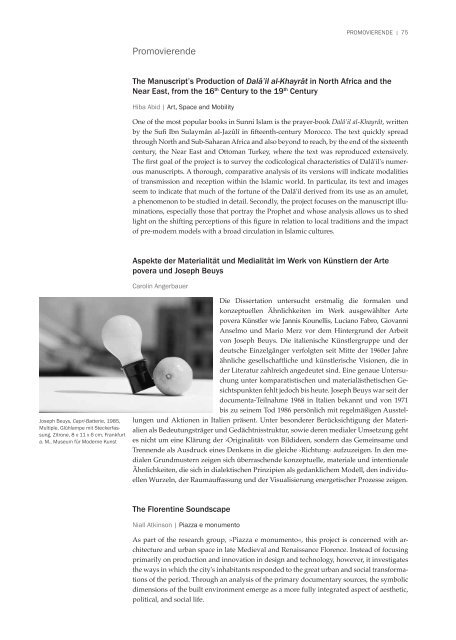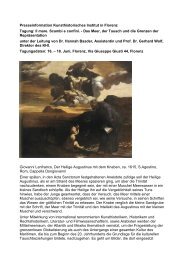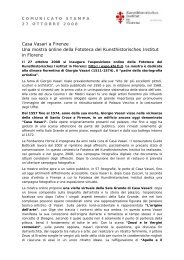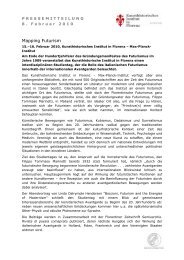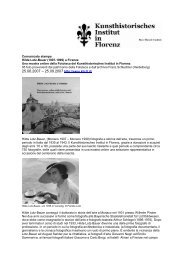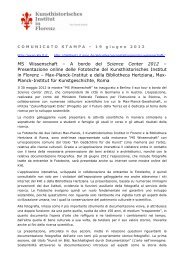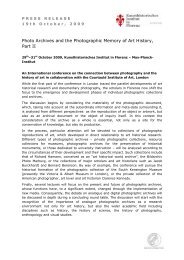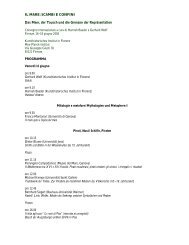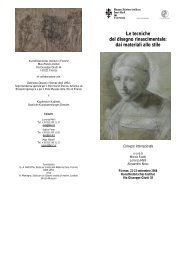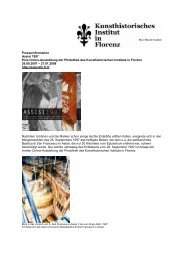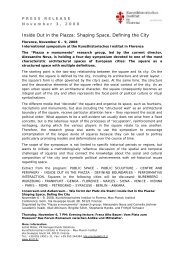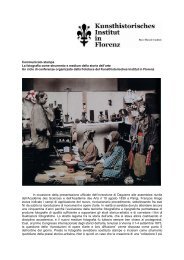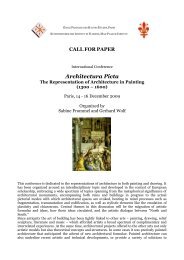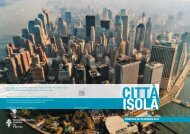forschungsbericht november 2008 – juli 2012 - Kunsthistorisches ...
forschungsbericht november 2008 – juli 2012 - Kunsthistorisches ...
forschungsbericht november 2008 – juli 2012 - Kunsthistorisches ...
Erfolgreiche ePaper selbst erstellen
Machen Sie aus Ihren PDF Publikationen ein blätterbares Flipbook mit unserer einzigartigen Google optimierten e-Paper Software.
PROMOVIERENDE | 75<br />
Promovierende<br />
The Manuscript’s Production of Dalâ’il al-Khayrât in North Africa and the<br />
Near East, from the 16 th Century to the 19 th Century<br />
Hiba Abid | Art, Space and Mobility<br />
One of the most popular books in Sunni Islam is the prayer-book Dalâ’il al-Khayrât, written<br />
by the Sufi Ibn Sulaymân al-Jazûlî in fifteenth-century Morocco. The text quickly spread<br />
through North and Sub-Saharan Africa and also beyond to reach, by the end of the sixteenth<br />
century, the Near East and Ottoman Turkey, where the text was reproduced extensively.<br />
The first goal of the project is to survey the codicological characteristics of Dalâ'il's numerous<br />
manuscripts. A thorough, comparative analysis of its versions will indicate modalities<br />
of transmission and reception within the Islamic world. In particular, its text and images<br />
seem to indicate that much of the fortune of the Dalâ'il derived from its use as an amulet,<br />
a phenomenon to be studied in detail. Secondly, the project focuses on the manuscript illuminations,<br />
especially those that portray the Prophet and whose analysis allows us to shed<br />
light on the shifting perceptions of this figure in relation to local traditions and the impact<br />
of pre-modern models with a broad circulation in Islamic cultures.<br />
Aspekte der Materialität und Medialität im Werk von Künstlern der Arte<br />
povera und Joseph Beuys<br />
Carolin Angerbauer<br />
Joseph Beuys, Capri-Batterie, 1985,<br />
Multiple, Glühlampe mit Steckerfassung,<br />
Zitrone, 8 x 11 x 6 cm, Frankfurt<br />
a. M., Museum für Moderne Kunst<br />
Die Dissertation untersucht erstmalig die formalen und<br />
konzeptuellen Ähnlichkeiten im Werk ausgewählter Arte<br />
povera Künstler wie Jannis Kounellis, Luciano Fabro, Giovanni<br />
Anselmo und Mario Merz vor dem Hintergrund der Arbeit<br />
von Joseph Beuys. Die italienische Künstlergruppe und der<br />
deutsche Einzelgänger verfolgten seit Mitte der 1960er Jahre<br />
ähnliche gesellschaftliche und künstlerische Visionen, die in<br />
der Literatur zahlreich angedeutet sind. Eine genaue Untersuchung<br />
unter komparatistischen und materialästhetischen Gesichtspunkten<br />
fehlt jedoch bis heute. Joseph Beuys war seit der<br />
documenta-Teilnahme 1968 in Italien bekannt und von 1971<br />
bis zu seinem Tod 1986 persönlich mit regelmäßigen Ausstellungen<br />
und Aktionen in Italien präsent. Unter besonderer Berücksichtigung der Materialien<br />
als Bedeutungsträger und Gedächtnisstruktur, sowie deren medialer Umsetzung geht<br />
es nicht um eine Klärung der ›Originalität‹ von Bildideen, sondern das Gemeinsame und<br />
Trennende als Ausdruck eines Denkens in die gleiche ›Richtung‹ aufzuzeigen. In den medialen<br />
Grundmustern zeigen sich überraschende konzeptuelle, materiale und intentionale<br />
Ähnlichkeiten, die sich in dialektischen Prinzipien als gedanklichem Modell, den individuellen<br />
Wurzeln, der Raumauffassung und der Visualisierung energetischer Prozesse zeigen.<br />
The Florentine Soundscape<br />
Niall Atkinson | Piazza e monumento<br />
As part of the research group, »Piazza e monumento«, this project is concerned with architecture<br />
and urban space in late Medieval and Renaissance Florence. Instead of focusing<br />
primarily on production and innovation in design and technology, however, it investigates<br />
the ways in which the city's inhabitants responded to the great urban and social transformations<br />
of the period. Through an analysis of the primary documentary sources, the symbolic<br />
dimensions of the built environment emerge as a more fully integrated aspect of aesthetic,<br />
political, and social life.


